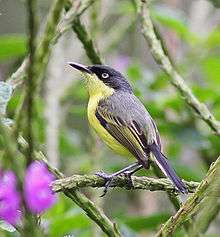Common tody-flycatcher
The common tody-flycatcher or black-fronted tody-flycatcher (Todirostrum cinereum) is a very small passerine bird in the tyrant flycatcher family. It breeds from southern Mexico to northwestern Peru, eastern Bolivia and southern, eastern and northeast Brazil.

| Common tody-flycatcher | |
|---|---|
| in the Pantanal, Brazil | |
| Scientific classification | |
| Kingdom: | Animalia |
| Phylum: | Chordata |
| Class: | Aves |
| Order: | Passeriformes |
| Family: | Tyrannidae |
| Genus: | Todirostrum |
| Species: | T. cinereum |
| Binomial name | |
| Todirostrum cinereum (Linnaeus, 1766) | |
The common tody-flycatcher is a tiny, big-headed bird, 9.5–10.2 cm (3.7–4.0 in) long, weighing 6.5–6.8 g (0.23–0.24 oz), and with a long, flattened, straight black bill. The upper head is black, shading to dark grey on the nape and dark olive-green on the rest of the upperparts. The usually cocked tail is black with white tips, and the wings are blackish with two yellow wing bars and yellow edging to the feathers. The underparts are entirely yellow. Sexes are similar, but young birds have a greyer upper head, buff wing markings, and paler underparts.
Males of this species have a rapid grasshopper-like ticking te’e’e’e’e’e’t call something like a tropical kingbird, and a dawn song consisting of a very fast high tic repeated up to 110 times a minute for minutes on end.
It is a very common inhabitant in gardens, shady plantations, second growth and the edges and clearings of forest, although it avoids the dense interior of mature woodland and also arid areas. The common tody-flycatcher is usually seen in pairs, making rapid dashing sallies or hovering to pick small arthropods off the vegetation.[2] It often wags its tail as it moves sideways along branches.
It breeds from sea level to 1,150 m (3,770 ft) altitude, locally to 1,500 m (4,900 ft). Both male and female birds build a pouch nest with a visored side entrance, which is usually suspended from a thin branch or vine 1–5 m (3.3–16.4 ft) high in a tree, though occasionally it can go up to 30 m (98 ft). The female incubates the two usually unspotted white eggs for the 15–16 days prior to hatching.
Common names
- English: black-fronted tody-flycatcher, common tody-flycatcher
- Spanish: titirijí común, titirijí lomicenizo, espatulilla amarilla, mosquerito común
- Portuguese: ferreirinho, ferreirinho-relógio, reloginho, relógio, sebinho-relógio
References
- BirdLife International (2012). "Todirostrum cinereum". IUCN Red List of Threatened Species. 2012. Retrieved 26 November 2013.CS1 maint: ref=harv (link)
- de A. Gabriel, Vagner; Pizo, Marco A. (2005). "Foraging behavior of tyrant flycatchers (Aves, Tyrannidae) in Brazil" (PDF). Revista Brasileira de Zoologia. 22 (4): 1072–1077. doi:10.1590/S0101-81752005000400036.
- Hilty, Steven L. (2003). Birds of Venezuela. Princeton University Press. ISBN 0-7136-6418-5.
- Stiles, F. Gary; Skutch, Alexander F. (1989). A Guide to the Birds of Costa Rica. Comstock Publishing Associates. ISBN 0-8014-9600-4.
External links
| Wikimedia Commons has media related to Todirostrum cinereum. |
| Wikispecies has information related to Todirostrum cinereum |
- "Common tody-flycatcher media". Internet Bird Collection.
- Common tody-flycatcher photo gallery at VIREO (Drexel University)
- Common tody-flycatcher species account at Neotropical Birds (Cornell Lab of Ornithology)
- Interactive range map of Todirostrum cinereum at IUCN Red List maps
- Audio recordings of Common tody-flycatcher on Xeno-canto.
